<< Previous | Displaying results 6251-6300 of 6768 for "" | Next >>
Polish hostages in the Old Market Square. Bydgoszcz, Poland, September 9–10, 1939. Just after the German invasion of Poland, armed groups of ethnic Germans in the city of Bydgoszcz staged an uprising against the local Polish garrison. This was put down by the next day, one day prior to the entrance of German troops in the city on September 5. A local command structure was quickly put into place by Major General Walter Braemer, and in response to continued attacks upon German personnel in the city,…
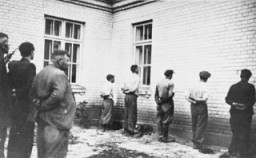
German soldiers execute Piotr Sosnowski, a priest from Tuchola. Piasnica Wielka, Poland, 1939.
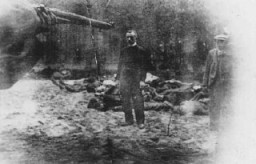
German soldiers hold Poles, including Polish clerics, hostage. Bydgoszcz, Poland, September 9, 1939.
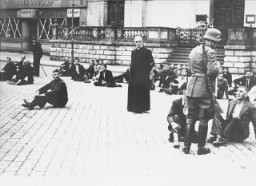
A page from SS officer Juergen Stroop's report on the Warsaw ghetto uprising. He wrote: "This is what the former Jewish residential quarter looks like after its destruction." Warsaw, Poland, April-May, 1943.
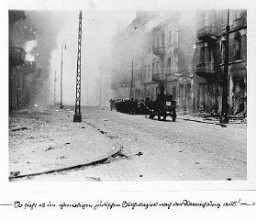
An underground bunker, built by Jews in Warsaw in preparation for anti-Nazi resistance. This photograph shows cooking facilities in a bunker. Jews hid in bunkers while the Germans systematically destroyed the ghetto during the uprising. Warsaw, Poland, April 19–May 16, 1943.
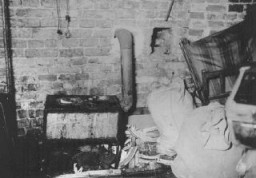
A mass marriage of 50 couples in Berlin. All of the couples belonged to the Nazi Party. Berlin, Germany, July 2, 1933.
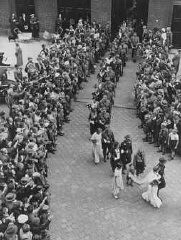
Young survivors of the Buchenwald concentration camp soon after liberation. Germany, April-June 1945.
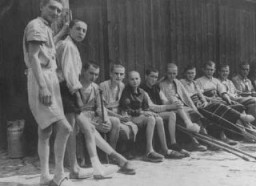
View of the courtroom during the trial of John Demjanjuk. Chief defense counsel Mark J. O'Connor addresses the court during the first session of the trial. Jerusalem, Israel, February 16, 1987.
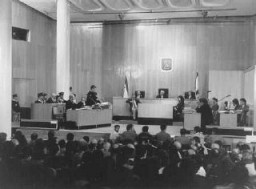
Fascist supporters during the "March on Rome," after which Fascist leader Benito Mussolini was appointed Italian Prime Minister. Italy, October 1922.
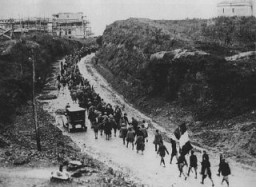
Chart used by the prosecution in the Doctors' Trial illustrates the organization of the Medical Services of the Wehrmacht (German armed forces). Nuremberg, Germany, December 9, 1946-August 20, 1947.
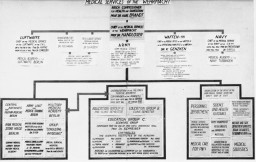
Nazi officials and Catholic bishops listen to a speech by Wilhelm Frick, Reich Minister of the Interior, at an official ceremony in the Saarbrucken city hall marking the reincorporation of the Saarland into the German Reich. March 1, 1935. Among those pictured is Joseph Goebbels (seated at the far right), Franz Rudolf Bornewasser (Bishop of Trier) and Ludwig Sebastian (Bishop of Speyer).
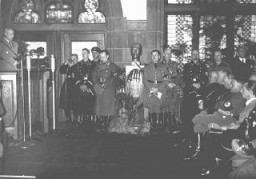
A German soldier stands on a toppled Polish monument. Krakow, Poland, 1940. This statue commemorated the Polish victory at Grunwald over the Teutonic knights in 1410. In accordance with the plans of German occupation authorities in Poland, all physical symbols of Polish national culture were to be obliterated to make way for the "Germanization" of the country.
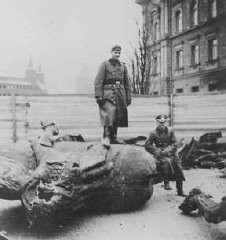
A group of children assembled for deportation to Chelmno. During the roundup known as the "Gehsperre" Aktion, the elderly, infirm, and children were rounded up for deportation. Lodz, Poland, September 5-12, 1942.

German police round up Jews and load them onto trucks in the Ciechanow ghetto. Ciechanow, Poland, 1941-1942.
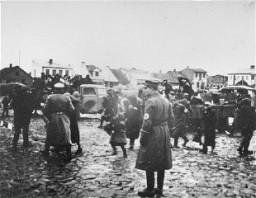
Containers of Zyklon B poison gas pellets found at the Majdanek camp after liberation. Poland, after July 22, 1944.
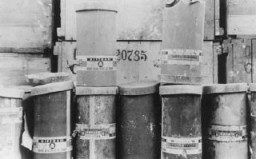
Sigmund Freud and daughter Anna in Paris, en route to exile in England. June 1938.
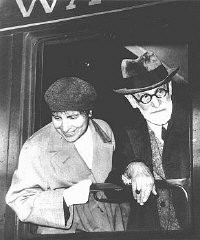
Two emaciated female Jewish survivors of a death march lie in an American military field hospital in Volary, Czechoslovakia. Pictured on the left is seventeen-year-old Nadzi Rypsztajn.The original caption reads "This girl, only seventeen years old, was forced to march 18 miles a day for 30 days on one bowl of soup a day. The 5th Infantry Division of the U.S. Third Army found 150 in the same condition when they entered Volary, Czechoslovakia."
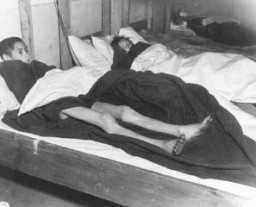
A Hungarian Jewish youth identifies the body of his father, who was shot by the SS during a death march from Flossenbürg. Members of the US military prepare the victims' burial. Neunburg, Germany, April 25, 1945.
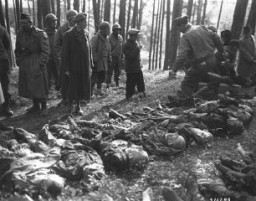
Sofia Karpuk holds a name card intended to help any of her surviving family members locate her at the Kloster Indersdorf displaced persons camp. This photograph was published in newspapers to facilitate reuniting the family. Kloster Indersdorf, Germany, October-November 1945.
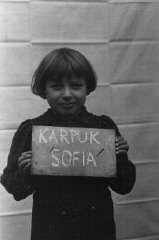
Jewish wedding in Morocco, 1942. Photo: US Holocaust Memorial Museum, courtesy of YIVO Institute for Jewish Research
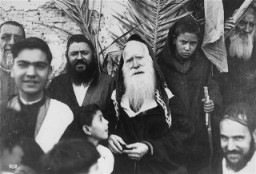
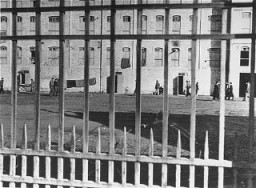
Adolf Berman speaks at a memorial service commemorating the Warsaw ghetto uprising. The building in the background, destroyed during the 1943 uprising, held the office of the Jewish council. Warsaw, Poland, 1945. During the German occupation, Berman was active in the Jewish underground and played a leadership role in the Council for Aid to Jews, known as Zegota.
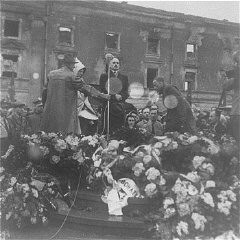
First grade pupils, both Jewish and non-Jewish, study in a classroom in a public school in Hamburg. Germany, June 1933.
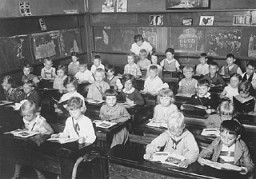
Prewar family photograph of Berta and Inge Engelhard holding pigeons in a public square in Munich. Photograph taken in Munich, Germany, 1937. Following increased anti-Jewish measures, Berta and brother Theo (not pictured here) left Germany on a Kindertransport in January 1939. Inge followed on a different transport a few months later. While the siblings were eventually housed together in England, they faced many challenges during the war including the pain of separation from their parents. Parents Moshe…
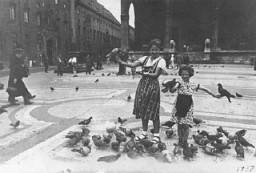
Horst Wessel leads his SA formation through the streets of Nuremberg during the fourth Nazi Party Congress in August 1929.
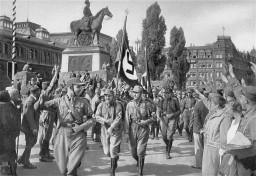
A crowd stands outside of a polling center in Berlin during the German national election in January 1919. This was the first election held under the Weimar Republic (1918–1933), as well as the first election in which women had the legal right to vote in Germany. Women's suffrage was declared in Germany only a couple of months earlier, on November 12, 1918. © IWM Q 110868
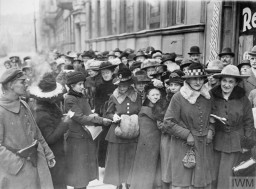
This photo shows a placard urging Hungarian Jews to unite against rising antisemitism in prewar Hungary and Europe. It rallies Jews to protest, using such phrases as: "Protect Jewish honor!”; “Do not buy from our enemies!”; and “Do not watch movies from the Third Reich." Hungary, 1937.
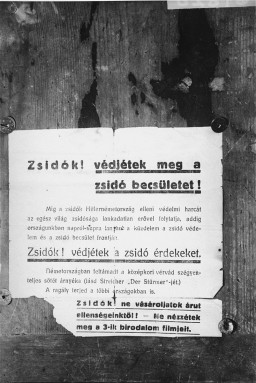
The armistice that ended the hostilities of World War I was signed in a railcar in the Forest of Compiègne. The railcar belonged to French Marshal Ferdinand Foch, the commander of the victorious Allied forces. © IWM Q 61172
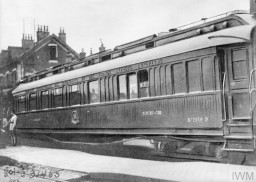
A digital representation of the United States 101st Airborne Division's flag. The US 101st Airborne Division (the "Screaming Eagles" division) was established in 1942. During World War II, they were involved in D-Day and the Battle of the Bulge. The division also captured the city of Eindhoven and uncovered the Kaufering IV camp. The 101st Airborne Division was recognized as a liberating unit in 1988 by the United States Army Center of Military History and the United States Holocaust Memorial Museum…
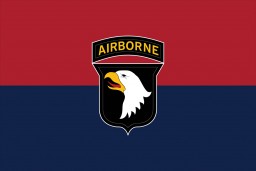
A digital representation of the United States 103rd Infantry Division flag. The US 103rd Infantry Division (the "Cactus" division) was established in 1942. During World War II, they were involved in the Battle of the Bulge and captured the city of Innsbruck. The division also uncovered a Nazi subcamp attached to Kaufering camp complex. The 103rd Infantry Division was recognized as a liberating unit in 1985 by the US Army's Center of Military History and the United States Holocaust Memorial Museum…
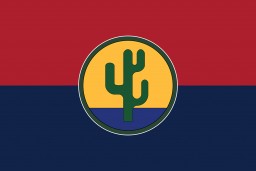
A digital representation of the United States 104th Infantry Division's flag. The US 104th Infantry Division (the "Timberwolf" division) was activated in 1942. During World War II, they captured the cities of Cologne and Halle. The division also overran Nordhausen and the Dora-Mittelbau concentration camp. The 104th Infantry Division was recognized as a liberating unit in 1988 by the United States Army Center of Military History and the United States Holocaust Memorial Museum (USHMM).
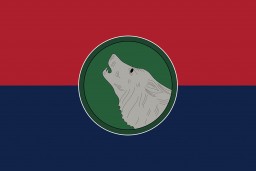
A digital representation of the United States 10th Armored Division's flag. The US 10th Armored Division is also known as the "Tiger" division. During World War II, they captured the cities of Trier and Oberammergau. The division also overran a Dachau subcamp. The 10th Armored Division was recognized as a liberating unit in 1985 by the United States Army Center of Military History and the United States Holocaust Memorial Museum (USHMM).
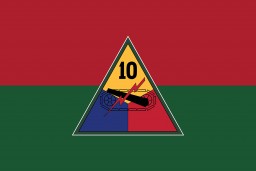
A digital representation of the United States 11th Armored Division's flag. The US 11th Armored Division (the "Thunderbolt" division) was formed in 1942. During World War II, they were involved in the Battle of the Bulge and captured the cities of Coburg, Bayreuth, and Linz. The division also overran the Mauthausen and Gusen concentration camps. The 11th Armored Division was recognized as a liberating unit in 1985 by the United States Army Center of Military History and the United States Holocaust…
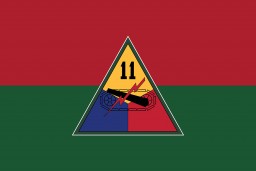
A digital representation of the United States 12th Armored Division's flag. The US 12th Armored Divison is also known as the "Hellcats" division. During World War II, they captured the cities of Ludwigshafen and Würzburg. The division also overran a subcamp of Dachau. The 12th Armored Division was recognized as a liberating unit in 1988 by the United States Army Center of Military History and the United States Holocaust Memorial Museum (USHMM).
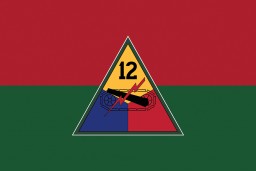
A digital representation of the United States 14th Armored Division's flag. The US 14th Armored Division (the "Liberators" division) joined the war in 1944. During World War II, they uncovered several subcamps of Dachau, three large forced-labor camps, and several other nearby camps. The 14th Armored Division was recognized as a liberating unit in 1991 by the United States Army Center of Military History and the United States Holocaust Memorial Museum (USHMM).

A digital representation of the United States 1st Infantry Division's flag. The US 1st Infantry Division (the "Big Red One" division) was formed in 1917 and fought in World War I. During World War II, they were involved in the Allied invasions of North Africa and Italy, as well as D-Day and the Battle of the Bulge. Additionally, the division captured the city of Aachen and liberated Zwodau and Falkenau an der Eger, two subcamps of Flossenbürg. The 1st Infantry Division was recognized as a liberating…
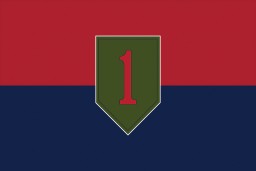
A digital representation of the United States 20th Armored Division's flag. The US 20th Armored Division was occasionally known as the "Armoraiders" during World War II. They participared in the liberation of the Dachau concentration camp. The 20th Armored Division was recognized as a liberating unit in 1985 by the United States Army Center of Military History and the United States Holocaust Memorial Museum (USHMM).
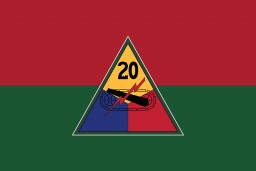
A digital representation of the United States 26th Infantry Division's flag. The US 26th Infantry Division (the "Yankee" division) was formed in 1917 and fought in World War I. During World War II, they were involved in the Battle of the Bulge and captured the city of Linz. The division also overran the Gusen concentration camp. The 26th Infantry Division was recognized as a liberating unit in 2002 by the United States Army Center of Military History and the United States Holocaust Memorial Museum…
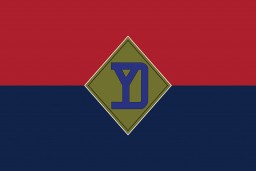
A digital representation of the United States 29th Infantry Division's flag. The US 29th Infantry Division (the "Blue and Gray" division) was established in 1917 and fought in World War I. During World War II, they were involved in D-Day, as well as the liberation of Dinslaken civilian labor camp. The 29th Infantry Division was recognized as a liberating unit in 1995 by the United States Army Center of Military History and the United States Holocaust Memorial Museum (USHMM).
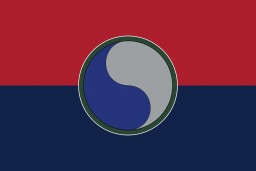
A digital representation of the United States 2nd Infantry Division's flag. The US 2nd Infantry Division (the "Indianhead" division) was created in 1917 and fought in World War I. During World War II, they were involved in D-Day and the Battle of the Bulge. They also captured the cities of Leipzig and Hadamar. Additionally, the division overran Leipzig-Schönefeld, a subcamp of Buchenwald, and liberated prisoners at the Spergau/Zöschen camp. The 2nd Infantry Division was recognized as a liberating unit…
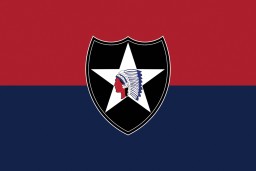
A digital representation of the United States 30th Infantry Division's flag. The US 30th Infantry Division (the "Old Hickory" division) was established in 1917 and fought in World War I. During World War II, they were involved in the Battle of the Bulge and also liberated Weferlingen, a subcamp of Buchenwald. The 30th Infantry Division was recognized as a liberating unit in 2012 by the United States Army Center of Military History and the United States Holocaust Memorial Museum (USHMM).
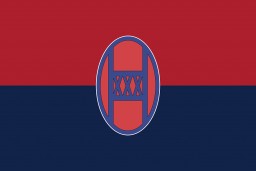
A digital representation of the United States 36th Infantry Division's flag. The US 36th Infantry Division (the "Texas" or "Lone Star" division) was established in 1917 and fought in World War I. During World War II, they were involved in the Allied invasions of North Africa and the Battle of the Bulge. The division also overran some of the Kaufering subcamps of the Dachau concentration camp. The 36th Infantry Division was recognized as a liberating unit in 1995 by the United States Army Center of…
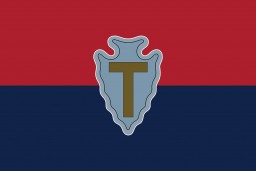
A digital representation of the United States 3rd Armored Division's flag. The US 3rd Armored Division (the "Spearhead" division) was established in 1941. During World War II, they were involved in the Battle of the Bulge and captured the city of Cologne. The division also discovered the Dora-Mittelbau concentration camp. The 3rd Armored Division was recognized as a liberating unit in 1985 by the United States Army Center of Military History and the United States Holocaust Memorial Museum (USHMM).
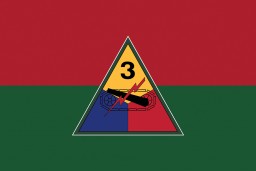
A digital representation of the United States 42nd Infantry Division's flag. The US 42nd Infantry Division (the "Rainbow" division) was established in 1917 and fought in World War I. During World War II, they captured the cities of Würzburg, Schweinfurt, and Fürth. The division also entered the Dachau concentration camp. The 42nd Infantry Division was recognized as a liberating unit in 1985 by the United States Army Center of Military History and the United States Holocaust Memorial Museum…
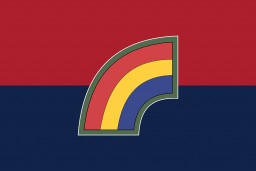
A digital representation of the United States 45th Infantry Division's flag. The US 45th Infantry Division (the "Thunderbird" division) was established in 1924. During World War II, they were involved in the Allied invasions of North Africa and Italy, as well as the capture of the city of Nuremberg. The division also liberated the Dachau concentration camp. The 45th Infantry Division was recognized as a liberating unit in 1985 by the United States Army Center of Military History and the United States…
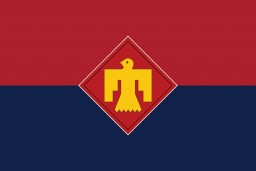
A digital representation of the United States 4th Armored Division's flag. The US 4th Armored Division is also known as the "Breakthrough" division. During World War II, they were involved in the Battle of the Bulge and overran Ohrdruf, a subcamp of Buchenwald. The 4th Armored Division was recognized as a liberating unit in 1985 by the United States Army Center of Military History and the United States Holocaust Memorial Museum (USHMM).
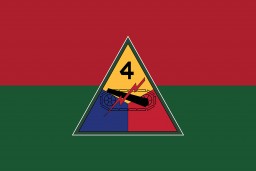
A digital representation of the United States 4th Infantry Division's flag. The US 4th Infantry Division (the "Ivy" division) was established in 1917 and fought in World War I. During World War II, they were involved in D-Day, the liberation of Paris, and the Battle of the Bulge. The division also captured the city of Nuremberg and discovered a Dachau subcamp near Haunstetten. The 4th Infantry Division was recognized as a liberating unit in 1992 by the United States Army Center of Military History and…
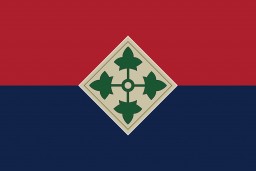
A digital representation of the United States 63rd Infantry Division's flag. The US 63rd Infantry Division (the "Blood and Fire" division) was established in 1943. During World War II, they took the town of Heidelberg and liberated several Kaufering subcamps. The 63rd Infantry Division was recognized as a liberating unit in 2000 by the United States Army Center of Military History and the United States Holocaust Memorial Museum (USHMM).
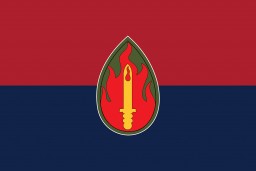
A digital representation of the United States 65th Infantry Division's flag. The US 65th Infantry Division (the "Battle Axe" division) was established in 1943. During World War II, they took the cities of Regensburg, Passau, and Linz. The division also overran a subcamp of the Flossenbürg concentration camp. The 65th Infantry Division was recognized as a liberating unit in 1994 by the United States Army Center of Military History and the United States Holocaust Memorial Museum (USHMM).
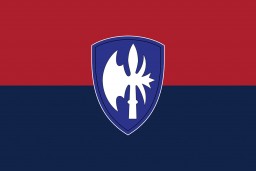
A digital representation of the United States 69th Infantry Division's flag. The US 69th Infantry Division ("Fighting 69th") was established in 1943. During World War II, they captured the city of Leipzig and uncovered Leipzig-Thekla, a subcamp of Buchenwald. The 69th Infantry Division was recognized as a liberating unit in 1993 by the United States Army Center of Military History and the United States Holocaust Memorial Museum (USHMM).
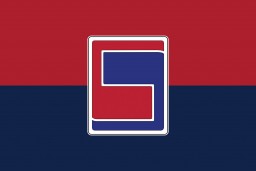
We would like to thank Crown Family Philanthropies, Abe and Ida Cooper Foundation, the Claims Conference, EVZ, and BMF for supporting the ongoing work to create content and resources for the Holocaust Encyclopedia. View the list of donor acknowledgement.